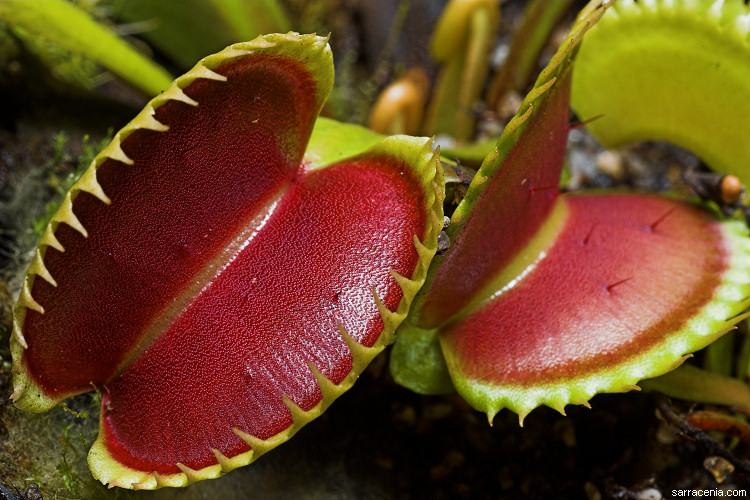Venus Flytrap: Adaptation & Co-Evolution
Thursday, 13 June 2013
Biogeography, Ecology & Habitat
 It is
native to the bogs and swamplands of North and South Carolina. It has been
introduced to a few other states and is also popular as a potted plant in many
parts of the world. It prefers lots of sunlight, humid conditions, and nutrient
poor, acidic soil. Native Venus flytrap plants have a habitat that has full
sun, good air circulation, and porous, well draining, acidic and moist soil
that is usually poor in nutrients such as, nitrogen.
It is
native to the bogs and swamplands of North and South Carolina. It has been
introduced to a few other states and is also popular as a potted plant in many
parts of the world. It prefers lots of sunlight, humid conditions, and nutrient
poor, acidic soil. Native Venus flytrap plants have a habitat that has full
sun, good air circulation, and porous, well draining, acidic and moist soil
that is usually poor in nutrients such as, nitrogen. General Adaptations
 For
reproductive purposes, the flowers of Venus flytraps usually grow on tall
stalks far above the leaves. This is so that the insects pollinating the
flowers don’t get trapped in the leaves. This is an anatomical adaptation that
affects the flowers and the stems.
For
reproductive purposes, the flowers of Venus flytraps usually grow on tall
stalks far above the leaves. This is so that the insects pollinating the
flowers don’t get trapped in the leaves. This is an anatomical adaptation that
affects the flowers and the stems. Another anatomical adaptation is the hair-like teeth at the edge of the leaves that helps seal the prey inside. Sealing the prey inside prevents other predators from coming along and stealing an insect or any nutrient being washed away by water or rain before the plant can digest them. The leaves are affected because of this adaptation.
Special Adaptation
Since Venus flytraps live in nutrient poor soil, they have adapted to capture
and digest insects to supplement their nutrient need.
One of the adaptations that make Venus flytrap a
Venus fly trap is its trapping mechanism. The two leaf parts of a trap are
laced together by a small stalk called petiole and there is a series of tiny,
sensitive hairs. If an unwary insect walks across these hairs, touching two or
more of them in succession, the leaf will close quickly, trapping the insect. It
is then slowly digested and absorbed by the leaf. Glands on the leaf surface
secrete several digestive enzymes that help to digest the insect. The leaf then
re-opens for another victim after one is digested.

This is an anatomical adaptation that affects
the leaves of the plant. This is because, the leaves carry out photosynthesis like any other
plant, but they also have many sensitive trigger hairs that allow the leaves to
close and hair-like teeth at the edge of the leaves to prevent the prey from
escaping. It is also a behavioural trait because, the just functions this way. It is also a physiological and chemical adaptation because the tiny,
sensitive hairs inside leaves cause the leaves to close, if triggered. There is
nectar and a smell that attracts the insects, and there are also glands on the
leaf surface that secrete digestive enzymes to help decompose and digest the
insect. This adaptation provides the plant with the essential nutrients that it
cannot get from the nutrient-poor soil.
Evolution by Natural Selection
If
Charles Darwin had found this plant during his travels, he would have explained
this adaptation through the idea of the survival of the fittest or natural
selection. He would have said that the trait for trapping and digesting insects
for nutrients existed in some individuals of the population while it did not
exist or was very poor for other individuals. He might have said that Venus
flytraps that have triggers which are more sensitive, faster reflexes to close
the leaves faster, have teeth at the edge of the leaves and/or produce better
digestive enzymes are better suited to survive the local conditions; while the
individuals that do not carry these traits will not get enough nutrition to
survive, so their population will slowly decline and eventually disappear since
they also cannot reproduce. Individuals that are better suited to survive do
not need to depend on the soil for nutrition and instead can trap and digest insects
for nutrients. They can survive to produce offsprings and pass on these strong,
helpful traits. This process has happened and will continue to happen slowly
over time.
Lamarckian Evolution
If
Jean Baptiste de Lamarck had seen this plant he would have described the evolution of this trait according to the theory of inheritance of acquired traits. He would have said, whatever traits the Venus fly trap has acquired during its lifetime, it has passed it on to its offspring. For example, if the plant grew really healthy because it has received a lot of sunlight, perfect soil condition, and sufficient nutrients, it will pass on this trait to its offspring too and they will also be healthy.
Subscribe to:
Posts (Atom)




